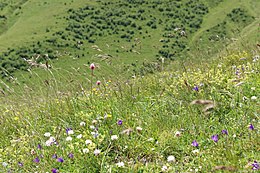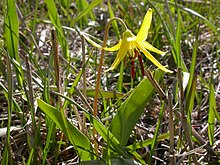Alpine plant
Alpine plants are
Alpine plants are adapted to the harsh conditions of the alpine environment, which include low temperatures, dryness, ultraviolet radiation, wind, drought, poor nutritional soil, and a short growing season.Some alpine plants serve as medicinal plants.

Ecology
Alpine plants occur in a tundra: a type of natural region or biome that does not contain trees. Alpine tundra occurs in mountains worldwide. It transitions to subalpine forests below the tree line; stunted forests occurring at the forest-tundra ecotone are known as Krummholz. With increasing elevation, it ends at the snow line where snow and ice persist through summer, also known as the Nival Zone.
Alpine plants are not limited to higher elevations. However, high-elevation areas have different ecology than those growing at higher latitudes.[3] One of the biggest distinctions is that the lower bound of a tropical alpine area is difficult to define due to a mixture of human disturbances, dry climates, and a naturally lacking tree line.[4] The other major difference between tropical and arctic-alpine ecology is the temperature differences. The tropics have a summer/winter cycle every day, whereas the higher latitudes stay cold both day and night. In the northern latitudes, the main factor to overcome is the cold.
Growth

Long-lived
Seedling establishment is very slow and occurs less often than vegetative reproduction.[8] In the first year of growth of perennial alpine plants, most of the photosynthate is used in establishing a stable root system which is used to help prevent desiccation and for carbohydrate storage over winter.[8] In this year, the plant may produce a few true leaves, but usually, only the cotyledons are produced.[8] It usually takes a few years for plants to become well established.[8]
Adaptations
Alpine plants can exist at very high elevations, from 300 to 6,000 metres (1,000 to 20,000 ft), depending on location.
To survive, alpine plants are adapted to the conditions at high elevations, including cold, dryness, high levels of
Surviving low temperature extremes
Most alpine plants are faced with low-temperature extremes at some point in their lives. There are several ways that a plant can survive these extremes. Plants can avoid exposure to low temperature by using different forms of seasonal
Photosynthesis and respiration rates
Photosynthesis and respiration rates are not uniform throughout the growing season.[15] At the start of the growing season, new shoots have low net photosynthesis rates and high respiration rates due to rapid growth of new shoots.[15] As the temperature rises in a plants microclimate, the net photosynthesis rates will increase as long as ample water is available and will peak during flowering.[15] Alpine plants are able to start photosynthesizing and reach maximum photosynthesis rates at lower temperatures compared to plants adapted to lower elevations and warmer climates.[15] This is due to the combined effects of genotype and environmental factors.[15]
Avoidance of desiccation
In alpine areas, water availability is often variable.
Avoidance of ultraviolet radiation
Because ultraviolet radiation tends to increase with elevation, it is often assumed to be a stress factor among alpine plants. In the past, there have been many attempts to research how ultraviolet radiation may influence alpine plant forms. However, it is uncertain if the growth and development of plants are affected by ultraviolet radiation. It is also not clear if the radiation is responsible for promoting genetic differentiation, leading to stunted growth forms.[13]
Reproduction
Alpine plants use both
Plants utilize different strategies to deal with these limits, including alternate flowering time and clonal propagation.Early flowering plants

Some plants flower immediately after snow melting or soil thawing. These early flowering plants always form their flowers in the previous season, called preformation. This flower
Mid-season flowering
Approximately half of all alpine species flower in mid-season. Flowering at the seasonal peak combines some of the advantages and risks of early flowering and late flowering plants. Some mid-season plants pre-form their inflorescences, but not all do.[17]
Late flowering
Late flowering occurs after the main growing season ends. They have a high seed output but their seeds have a reduced rate of maturing because of time constraints. These plants tend towards
Clonal propagation
Because investment in flowers and seed production can be costly for alpine plants, they often use

After establishment, each year new shoot growth occurs rapidly from the perennating bud which is usually located close to the soil surface.[8] This growth occurs after snowmelt when the soil temperature is above 0 °C.[8] Some species, like Erythronium grandiflorum, can begin new shoot growth before snowmelt as they have their perennating buds located in bulbs buried deep in the soil.[8] As new leaves protrude from the snow, the new shoots give off heat from thermal reradiation and/or respiratory heat which melts the surrounding snow.[8] This exposes more soil to solar radiation, heating it up and allowing new growth to accelerate.[8]
Medicinal alpine plants
There are a number of alpine plants that are used
See also
- Alpinum (garden)
- Alpine Garden Society
- Flora of the Alps
Notes
- ^ Körner 2003
- ^ Körner 2003, pp. 9–18.
- ^ Smith & Young 1987, p. 137
- ^ Smith & Young 1987, p. 138
- ^ Bliss 1962, p. 119
- ^ Bliss 1971, p. 407
- ^ Bliss 1962, pp. 127–128
- ^ a b c d e f g h i j k l m n o p q Billings 1974
- ^ a b "High Altitude Plants". Adventurers and Scientists for Conservation. Archived from the original on 2012-04-25. Retrieved 2016-11-22.
- ^ Bezruchka & Lyons 2011, p. 275
- ^ Zhang, Wang & Wang 2021
- ^ Stegner et al. 2020
- ^ a b c Körner 2003, pp. 101–114.
- ^ Hacker & Neuner 2008
- ^ a b c d e Billings & Mooney 1968
- ^ Austrheim, Hassel & Mysterud 2005
- ^ a b c d e f g h Körner 2003, pp. 259–290.
- ^ Tsukaya & Tsuge 2001
- ^ Laurentino, Telma G (2018-03-19). "Witnessing Evolution and Learning how to Think about it in the Wonderful Swiss Alps". sci five. University of Basel – via Medium.com.
- ^ Steinger, Körner & Schmid 1996
- ^ Kala 2005
- ^ a b Smith Olsen & Overgaard Larsen 2003
- ^ Kala 2000
References
- Austrheim, Gunnar; Hassel, Kristian; Mysterud, Atle (2005). "The Role of Life History Traits for Bryophyte Community Patterns in Two Contrasting Alpine Regions". S2CID 83519579.
- Bezruchka, Stephen; Lyons, Alonzo (2011). Trekking Nepal: A Traveler's Guide. The Mountaineers Books.
- Billings, W.D. (1974). "Adaptations and Origins of Alpine Plants". Arctic and Alpine Research. 6 (2): 129–142. JSTOR 1550081.
- Billings, W.D.; Mooney, H.A. (1968). "The Ecology of Arctic and Alpine Plants". Biological Reviews. 43 (4): 481–529. S2CID 85714370.
- Bliss, L.C. (1962). "Adaptations of arctic and alpine plants to environmental conditions". Arctic. 15 (2): 117–144. JSTOR 40506981.
- Bliss, L.C. (1971). "Arctic and Alpine Plant life Cycles". Annual Review of Ecology and Systematics. 2: 405–438. .
- Hacker, Jürgen; Neuner, Gilbert (2008). "Ice Propagation in Dehardened Alpine Plant Species Studied by Infrared Differential Thermal Analysis (IDTA)". Arctic, Antarctic, and Alpine Research. 40 (4): 660–670. S2CID 85721404.
- .
- Kala, Chandra Prakash (2005). "Health traditions of Buddhist community and role of amchis in trans-Himalayan region of India". Current Science. 89 (8): 1331–1338.
- Körner, Christian (2003). Alpine Plant Life: Functional Plant Ecology of High Mountain Ecosystems. Berlin: Springer. ISBN 978-3-540-00347-2.
- Smith, Alan; Young, Truman P. (1987). "Tropical Alpine Plant Ecology". Annual Review of Ecology and Systematics. 18: 137–158. .
- Smith Olsen, Carsten; Overgaard Larsen, Helle (2003). "Alpine medicinal plant trade and Himalayan mountain livelihood strategies". .
- Stegner, M; Lackner, B; Schäfernolte, T; Buchner, O; et al. (2020-09-24). "Winter Nights during Summer Time: Stress Physiological Response to Ice and the Facilitation of Freezing Cytorrhysis by Elastic Cell Wall Components in the Leaves of a Nival Species". Int J Mol Sci. 21 (19): 7042. PMID 32987913.
- Steinger, Thomas; Körner, Christian; Schmid, Bernhard (1996). "Long-term persistence in a changing climate: DNA analysis suggests very old ages of clones of alpine Carex curvula". S2CID 25924193.
- Tsukaya, H.; Tsuge, T. (2001). "Morphological Adaptation of Inflorescences in Plants that Develop at Low Temperatures in Early Spring: The Convergent Evolution of "Downy Plants"". Plant Biology. 3 (5): 536–543. S2CID 260251147.
- Zhang, Qi-Peng; Wang, Jian; Wang, Qian (2021-03-01). "Effects of abiotic factors on plant diversity and species distribution of alpine meadow plants". Ecological Informatics. 61: 101210. ISSN 1574-9541.
